The
Japanese page of this game is ready.
Buy this game
History †
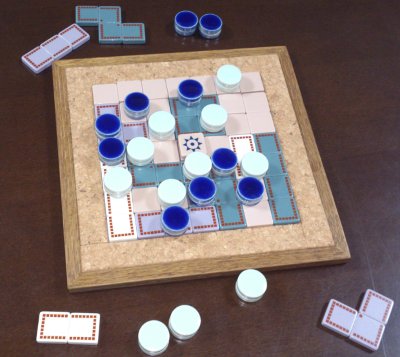
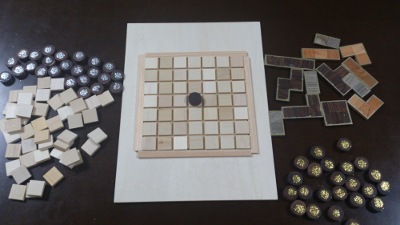
Renaissance was invented by Masahiro Nakajima, the Curator of 'The Museum of Abstract Strategy Games', in 2012.
Renaissance is an "Integrated Abstract Strategy Game," a totally new type of abstract strategy game, which have two different phases that require completely different strategies (competition over pieces in Phase1, and distribution of the acquired pieces on the board in Phase2) perfectly merged.
Please see the photo in the right. Renaissance, a game with graphical beauty and puzzle game flavor, is played with Polyomino pieces with 1 to 4 squares (Monomino, Domino, Triomino, Tetromino). While Renaissance is a pure abstract strategy game, collection of winning "hands" makes it an exciting and stimulating game, such as Mah-jong, Hana-fuda (Japanese playing cards), Poker, and Backgammon.
The game has been named "Renaissance" as the game has been designed in the motif of redevelopment (=Renaissance) in 2 Phases (building in the first Phase, and rebuilding from scratch in the second Phase).
Background of the Game Design †
There are multiple goals in the game design:
- To have puzzle game flavor with Polyomino tile pieces
- To propose fun to collect winning hands; such as Mah-jong, Hana-fuda (Japanese playing cards), while the game is a pure abstract strategy game
- To give strategic chances to win coming back from behind, between Phase1 and 2 in the same match
- To give good chances to win coming back from behind when multiple matches played (appropriate balance in point allocations)
- To be played as a "compound" abstract strategy game, that, for example, Project GIPF aimed for
BOARD & PIECES †
fig-01
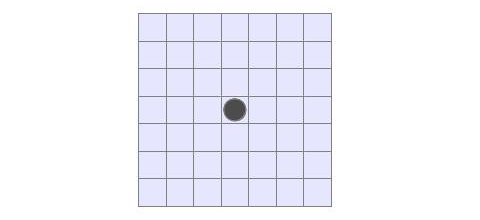
fig-02
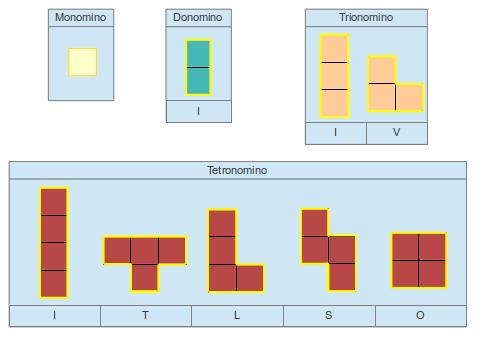
Equipment used in the game are shown in the photo on the top right.
48 squares of the 7x7 board (fig-01), other than the one in the center are used in the game; The center square is occupied and no pieces can enter.
"Polyomino" pieces (fig-02) are used in the game. Polyominoes are figures formed by joining one or more equal squares edge to edge connected. Polyominoes are classified according to how many cells they have: Names of each classified Polyominoes are composed of a Latin prefix of numbers of quadrates used and a Latin suffix "-omino."
| Number of Quadrate | Name | # of shapes when rotated or flipped considered identical | Comment |
| 1 | Monomino | 1 | A quadrate |
| 2 | Domino | 1 | Domino, you know... |
| 3 | Triomino | 2 | 3 quadrates |
| 4 | Tetromino | 5 | Known for Tetris |
| 5 | Pentomino | 12 | Used in Pentominoes / Quinn |
More Polyominoes exist with 6,7,8,9,10... and more quadrates.
In Renaissance, Monomino, Domino, Triomino, Tetromino are used as pieces.
Monominoes are used subsidiarily in the game. Each Polyomino piece has an Alphabet name, inspired by its shape (fig-02).
48 Monominoes, 4 Dominoes, 2 sets of 2 Triominoes, 1 set of 5 Tetrominoes are used in the game.
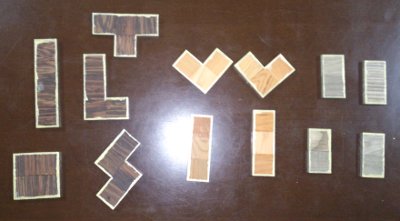
Players have 24 Markers each, in Gold or in Silver.
Game Play †
Preparation †
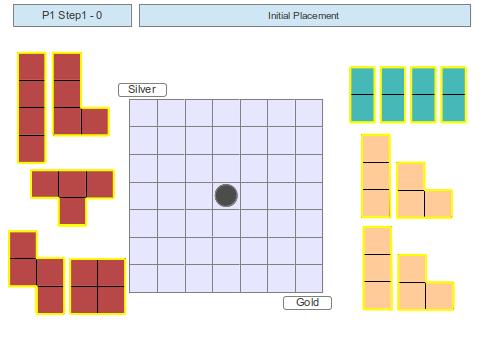 |
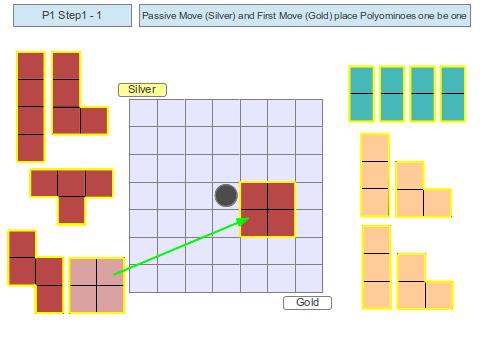 |
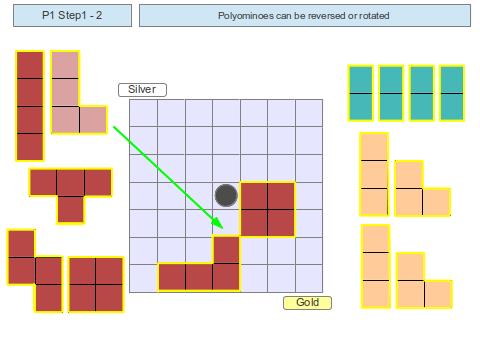
Arrangement of Polyominoes
- Silver Player goes first
- Players place Polyominoes one by one in turn on the board: They cannot be placed on top of other Polyominoes or on the center square
- Polyominoes can be rotated or flipped
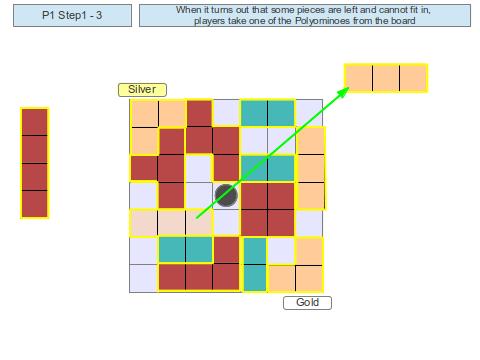 |
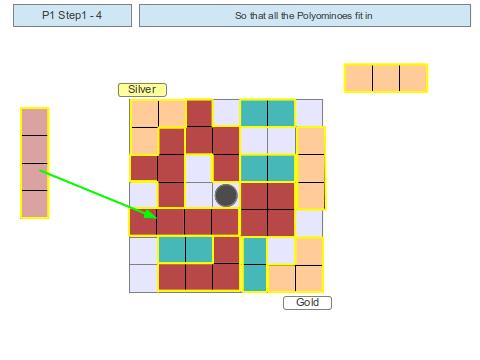 |
fig-08
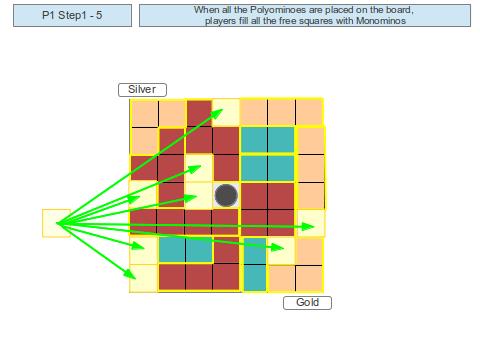
- When it turns out that some pieces are left and do not
fit in, players take one of the Polyominoes from the board
and relocate them on the board so that all the pieces fit in
- Polyominoes that are taken from the board cannot be placed back on the board in the same turn
- The Polyomino, placed on the board right after other one
taken, cannot be taken from the board
- When not all the pieces fit in after the adjustment with one piece, players take another piece from the board so that all the pieces fit in
- Players continue this adjustment till all the pieces are placed on the board
When all the Polyominoes are placed on the board, players fill all the free squares with Monominoes. (fig-08)
Phase 1 †
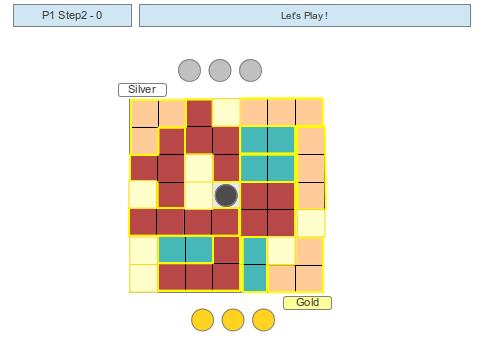
Players have 24 Markers in his/her color (Gold and Silver).
Gold Player places his/her Marker first.
Note:
Silver Player went first in placing Polyominoes. From this
part, Gold goes first.
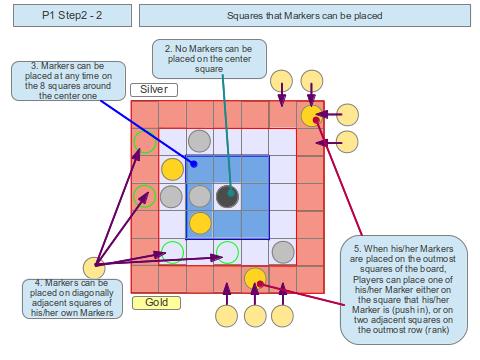
Instructions in placing Markers
- Markers cannot be placed on top of other Markers
- No Markers can be placed on the center square
- Markers can be placed on diagonally adjacent squares of the ones with his/her Markers
- Markers can be placed at any time on the 8 squares around the center one
- When his/her Markers are placed on the outmost squares of the board, Players can push his/her Marker in (See below for details.)
Push-in of his/her Marker when his/her Markers placed on the outmost squares of the board
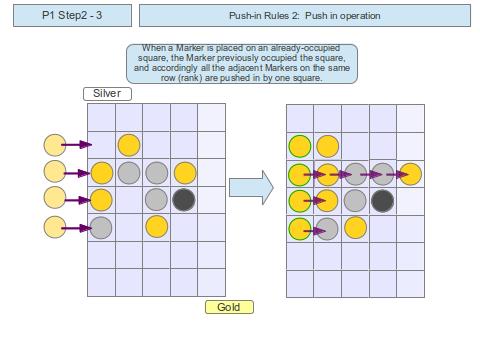 |
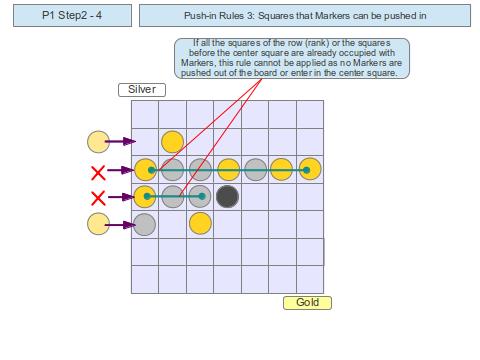 |
When his/her Markers are placed on the outmost squares of the board, Players can place one of his/her Marker either on the square that his/her Marker is (push in), or on two adjacent squares on the outmost row (rank).
When a Marker is placed on an already-occupied square, the Marker previously occupied the square, and accordingly all the adjacent Markers on the same row (rank) are pushed in by one square. The Markers on the same row (rank) as the pushed one(s) but with one or more free square(s) in between are not moved. If all the squares of the row (rank) or the squares before the center square are already occupied with Markers, this rule cannot be applied as no Markers are pushed out of the board or enter in the center square.
Acquisition of Polyominoes
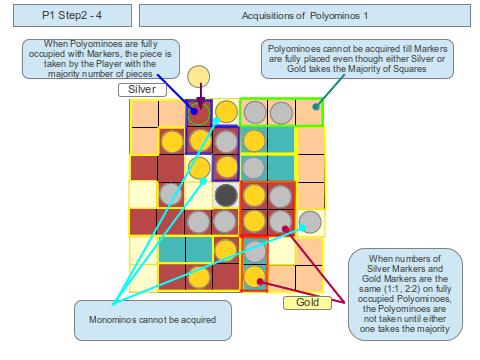 |
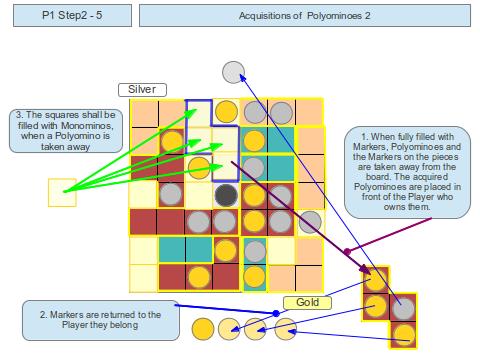 |
- When a Polyomino is fully occupied with Markers, the piece is taken by the Player who has placed the majority number of Markers on the piece
- When numbers of Silver Markers and Gold Markers are the same (1:1, 2:2) on fully occupied Polyominoes, the pieces are not taken until either color takes the majority.
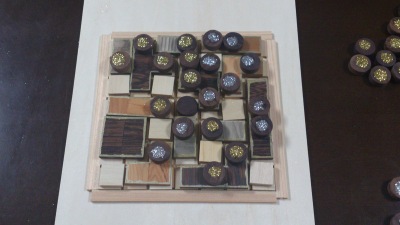
Operation on Acquisition of Polyominoes
- The Player who took the majority squares of the Polyomino takes the piece from the board
- Markers that were on the Polyomino are taken from the board at the same time and returned to Players
- Monominoes are placed on the squares where the taken Polyomino was
- There are cases that multiple Polyominoes are taken at one time from the board when Markers are pushed in
End of Phase1
Phase 1 ends when all the Polyominoes are taken from the board, followed by the score calculation.
In the endgame, there are cases that certain Polyomino(es) cannot be taken by either Player. If two Players agree, then Phase 1 ends, and the left Polyomino(es) is(are) taken away from the board: The piece(s) will not be used in Phase 2.
When Players agree that it is obvious which Player is to take the Polyomino(es) on the board before being occupied completely with Markers, the Polyomino(es) can be distributed as agreed then.
Good consideration is recommended here though; Although it
seems no chance is left to win the Polyomino(es), there may be,
with further consideration ![[wink]](/images/face/wink.png)
Score Calculation †
Basic Points
- 1 Point for 1 Polyomino acquired
Points for Hands
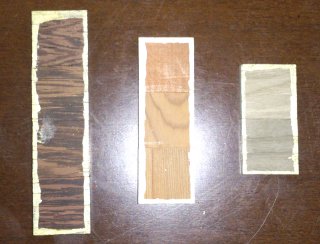
| Dominoes | 4 Dominoes | +4 points |
| Tri-I | 2 TriominoesのI | +2 points |
| Tri-V | 2 V Triominoes | +2 points |
| Triominoes | 4 Triominoes | +4 points |
| Tetrominoes | 5 Tetrominoes | +15 points |
| Triple I | "I"s: Do, Tri, Tetr (shown on the right) | +1 point / 1 "I" |
The points are accumulated for multiple hands.
Examples of Score Calculation
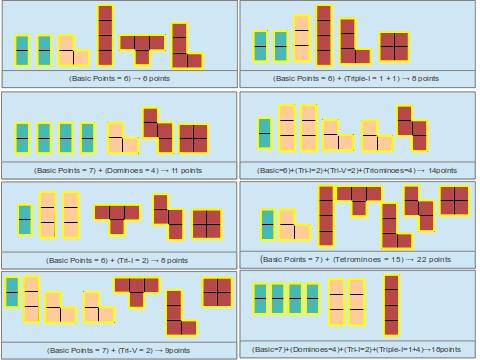
Phase 2 †
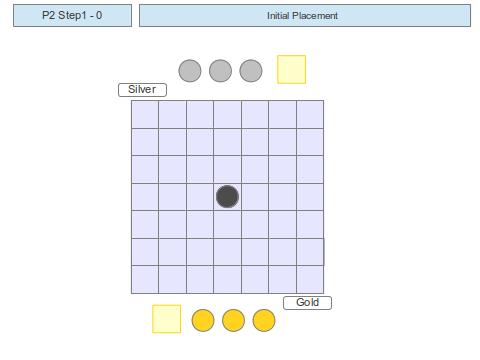 |
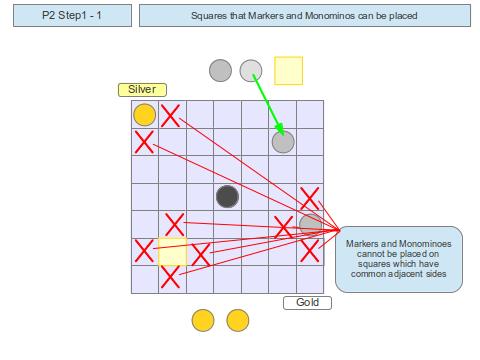 |
Cleanup †
All the Polyomino pieces and Markers placed on the board in Phase1 are taken away.
1 Monomino and 3 Markers for each Player and Polyominoes acquired in the Phase1 are used in the Phase2.
They are set out in front of each Player.
Preparation †
- Gold Player goes first. Players place 1 Monomino and 3 Markers on the board in turn.
- Markers and Monominoes cannot be placed on squares which have common adjacent sides (fig17).
- There are no fixed orders for Markers and Monominos to be placed.
- No Pass is allowed.
- When all the Markers and Monominoes are placed, Players go to the next step.
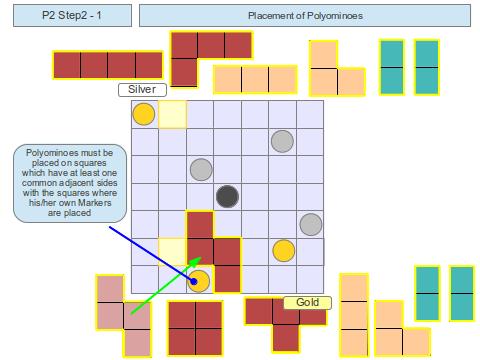
Relocation of Polyominoes †
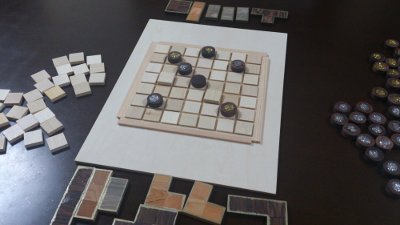
1 turn consists of two actions: "Place one of his/her Polyominoes on the board" and "Move a Marker to an adjacent square horizontally or vertically." (When "Place one of his/her Polyominoes on the board" is skipped, the whole turn is skipped; "Move a Marker to an adjacent square horizontally or vertically" is also skipped.) Players repeat the above two actions in turn till they finish placing their Polyominoes or till their Polyominoes in hand are left unplaced. Gold goes first.
Placement of Polyominoes
- Players place one of his/her Polyominoes on the board in turn: They cannot be placed on top of other Polyominoes, Markers or on the center square.
- Polyominoes must be placed on squares which have at least one common adjacent sides with the squares where his/her own Markers are placed.
Relocation of Markers
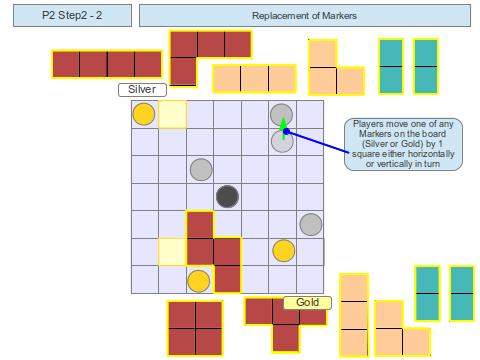 |
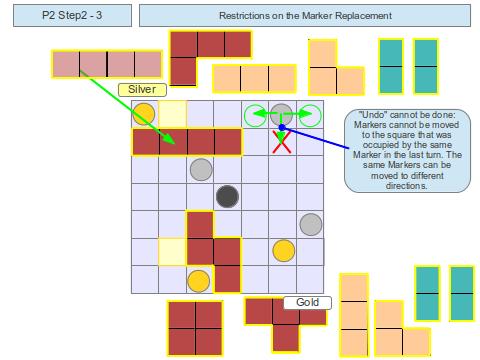 |
- Players move one of any Markers on the board (Silver or Gold) by 1 square either horizontally or vertically in turn.
- Markers cannot be placed on top of other Markers, Polyominoes or on the center square.
- "Undo" cannot be done: Markers cannot be moved to the squares that were occupied by the same Markers in the last turn. The same Markers can be moved only to different directions.
When Polyominoes cannot be placed or Markers cannot be moved
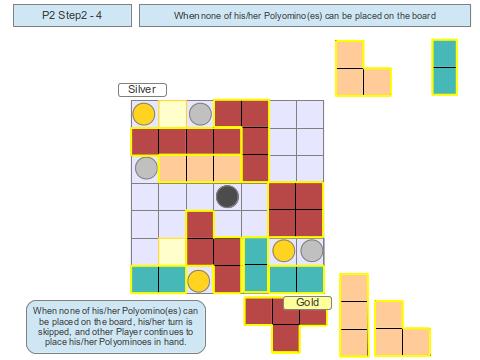 |
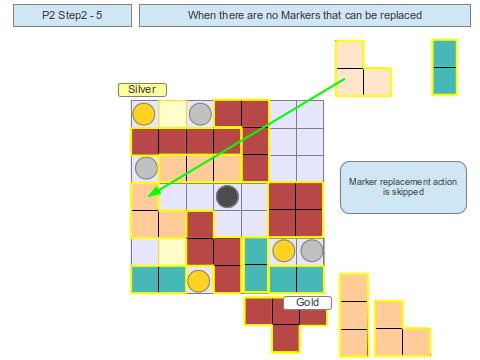 |
- When either Player finds that his/her Polyomino(es) in hand cannot be placed on the board, his/her turn is skipped, and other Player continues to place his/her Polyominoes on the board.
- When there are no Markers that can be moved, this action is skipped.
The Phase 2 match is over, when all the Polyominoes in hand are placed on the board or when Players decide that no more Polyominoes in their hand can be placed on the board (=they are left unplaced). Score is calculated as follows.
Score Calculation †
Number of quadrates in the Polyominoes left unplaced are counted for each Player.
- 1 Domino left unplaced: 2 points
- 1 Trimino left unplaced: 3 points
- 1 Tetromino left unplaced: 4 points
Don't you get excited with high points here: The points in
Phase 2 are penalties ![[worried]](/images/face/worried.png)
GOAL †
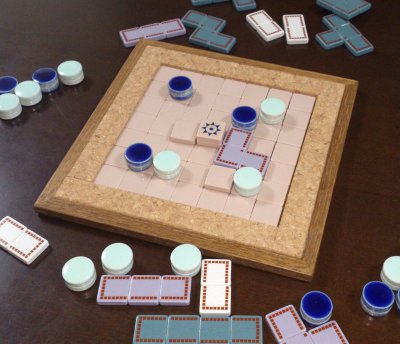
The points in Phase1 are added, and points in Phase2 are deducted. Total points are the Score of one Game.
Score of one Game = Total points in Phase1 - Total points in Phase2
When just one game is played, the Player who scored higher in the end of Phase2 is the winner.
Competition Rule †
Before starting the Game, Players agree on either of the following winning conditions, and on how many sets of Games they will play:
- The Player with more total points win the Game
- The Player with more winning Sets win the Game
It is more exciting to play even number of Sets (4-Set Game is good) with the Rule 1.
VARIANTS †
Play only Phase1 †
Phase1 can be played independently. In the official rules, the point allocation is designed for a complete Game with Phase1 and 2 but for Phase1 independent game, it should be interesting to add extra hands.
For example, you can add scores for the hands for certain "words" or "diagrams" (such as rectangles or diagrams with a hole in the middle...) that can be created with multiple Polyominoes.
Play only Phase2 †
Phase2 can also be played alone. It is quite interesting as well.
Polyominoes must be distributed before the Game Starts.
Polyominoes can be distributed as follows for example:
- The winner of Janken takes one and the other takes
another.
The winner of another Janken takes the third and the other takes the fourth. Players repeat this till the last piece is taken. - The winner of Janken chooses one piece for the opponent and the other does the same. Players repeat this till the last piece is taken.
NOTE †
Copyright © Masahiro Nakajima 2012, www.nakajim.net 2012, All rights reserved.
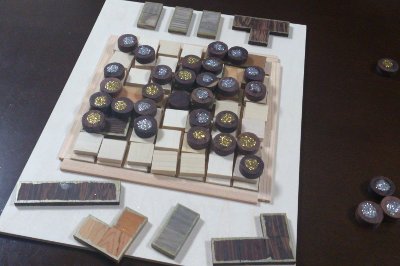
While I love creating small, simple and fun games, I really wanted to challenge creating an abstract, strategic and at the same time, exciting game this time.
Making and collecting hands, competing over the territories and points, and solving puzzles... I wanted to combine all of such fun flavors into one game, like a good RPG. I think Renaissance turned out to be such a game successfully, without losing important elements of an abstract strategy game.
When you play Renaissance, you will find it very simple. The game is very strategic and you will need to use totally different parts of brain in Phase1 and 2. I hope you enjoy the Game!
Special Thanks †
We would like to express our thanks to Satoshi Shimpuku at Irvine Systems, Inc. who has devoted much time on test play and balance adjustment of Renaissance, following Honey Donuts.
The Markers of the mock-up in the photo on the top right are
made of red sandalwood chips colored in gold and silver with
fine lame powders: The lame powders easily fell off ![[sad]](/images/face/sad.png)
and the hands, arms and faces of test players were all
glittering. You could tell who played the game at a glance
![[smile]](/images/face/smile.png) Thank you all!
Thank you all!
![[bigsmile]](/images/face/bigsmile.png)